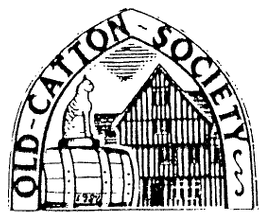Old Catton stained glass in the church at Plumstead (near Holt)



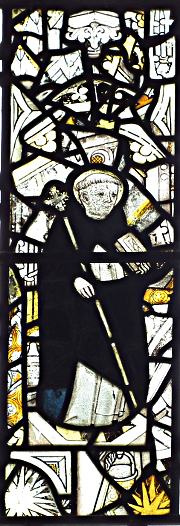
A Norfolk mystery surrounds the presence of medieval stained glass panels found some 20 miles north of Old Catton in the east and south windows of St Michael's Church, Plumstead, (Near Holt), and which originated from St Margaret’s Church, Old Catton.
The Plumstead Story
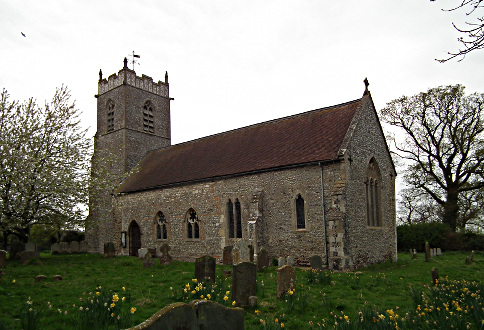 On 18 Aug 1950 the rector and churchwardens of Plumstead church (John Simson Coltart1 and Mrs Florence Newstead) sought a faculty from the Diocesan Advisory Committee for works to the church including the replacement of opaque glass with clear glass, within which panels of medieval stained glass obtained from Catton Hall would be placed. The latter glass was described as partly Norwich 15th century work and some later continental glass then in the workshops of Messrs G King and Son Ltd2, Norwich stained glass specialists.
On 18 Aug 1950 the rector and churchwardens of Plumstead church (John Simson Coltart1 and Mrs Florence Newstead) sought a faculty from the Diocesan Advisory Committee for works to the church including the replacement of opaque glass with clear glass, within which panels of medieval stained glass obtained from Catton Hall would be placed. The latter glass was described as partly Norwich 15th century work and some later continental glass then in the workshops of Messrs G King and Son Ltd2, Norwich stained glass specialists.
In response to a request from the Diocesan Advisory Committee Mr Coltart replied that Mrs Ketton-Cremer (of Felbrigg Hall) had seen the glass in Catton Hall and wrote to Mr Woodforde3 about it. He stated that the glass was a gift to St Michaels and that it was in Catton Hall when it was sold. He was of the opinion that the Gurneys or Buxtons had collected it somewhere and it's quality seems to have been unrecognised. It seemed much better to put it in a church than leave it in a country home.
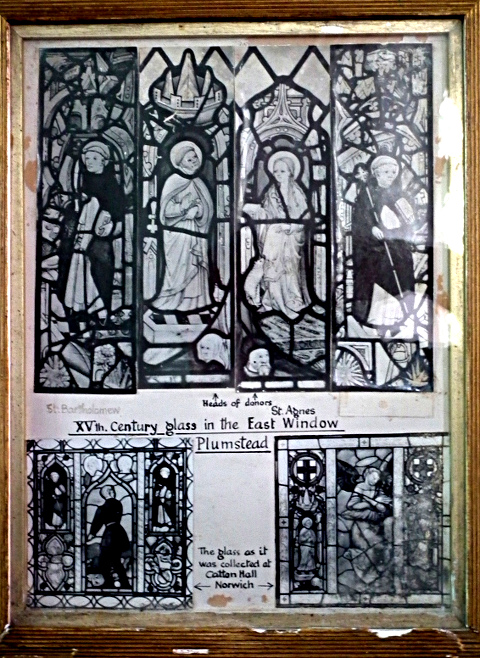 An entry in a Plumstead church cash book records that “In May 1952 the east window and south window of the chancel were re-glazed with clear glass, with panels of 15th century Norwich glass inserted in the east window: two panels of 17th century glass were put in the south window. This glass was in a collection at Catton Hall and was given to the church by Mr and Mrs Coltart."
An entry in a Plumstead church cash book records that “In May 1952 the east window and south window of the chancel were re-glazed with clear glass, with panels of 15th century Norwich glass inserted in the east window: two panels of 17th century glass were put in the south window. This glass was in a collection at Catton Hall and was given to the church by Mr and Mrs Coltart."
Inside the church, on the north wall opposite the door, is a framed and now faded black and white photograph. The lower section illustrates two sets of three panels with the legend “The glass as it was collected from Catton Hall”. Above are the enlarged views of the reworked panels as installed in the east window. A total of four figures and three quatrefoils are spread individually across the window.
More detail is found in a historical leaflet (2011) in the church by Lyn Stilgoe, which says:-
“The long narrow interior of the church is lit by its east and south windows containing some interesting pieces of glass, brought here from Catton Hall in 1950, given by J S Coltart. On the north nave wall are photos of how it was originally displayed in that house.
The east window has in its apex a quatrefoil showing the Agnus Dei, The Lamb of God. The central panels contain two good complete figures of 15C Norwich glass, which were formerly in tracery lights. The upper one is of a tonsured monk, and the lower one is St Agnes with her symbol of a lamb jumping up at her knees. Both these panels have been squared-off at the bottom edge with the addition of an extra piece showing a donor's head. In the north light is a quatrefoil showing two different heads, of perhaps a saint and a prophet, and below is a panel of made-up fragments, with a monk holding a long-shafted cross. On the south side is a quatrefoil of a made-up angel, with below another composite panel of perhaps a Benedictine monk, but holding a St Bartholomew's symbol of a flaying knife.
The south chancel window has tall panels of possibly French glass made in the 16/17C, showing a rather smug angel, with her halo hovering above and crossed arms, and a youth walking away into a rural landscape. This glass also came from Catton Hall and the photo displayed near the north doorway shows how it was displayed there surrounded by medieval glass panels.”
The two larger figures set separately in the south windows are little changed from the originals. It has to be said, however, that the glass as installed in the east window at Plumstead has been considerably reworked when compared with the black and white photographs. Above the main figures are three small quatrefoils. Close examination shows that the quatrefoils have been extracted from beneath the black-cloaked monks. The latter panels have then been squared-off by the addition of random fragments above their heads.
The shields emblazoned with crosses above the heads of the female figure and the white robed monk are not to be seen anywhere.
The Origins of the Glass in Old Catton
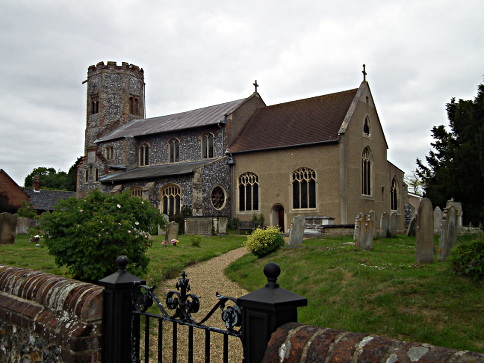 The Church of St Margaret, Old Catton, a round-tower church thought to be of late Norman origin, stands on the north side of Church Street, immediately adjacent to the Manor House to the west. The Manor House was the home of Robert Bronde (aka Robert de Catton). Born in Catton in about 1480, Robert was the son of John and Agnes Bronde. Entering monastic life, he was, by 1492, a Benedictine prior at the monastery which was part of Norwich Cathedral, later holding positions of sacristan and cellarer. He was instituted as rector of St Mary in the Marsh in 1526. He became a well-travelled man of considerable influence in the church and, in 1531, he was elected by the monks of St. Albans to be their abbot, at which time St Albans was the most senior abbey in England. He had important political contacts being close to Thomas Cromwell and, finding favour with the court, being invited to the baptism of the future Queen Elizabeth I in 1533. He died St Albans in 1552.
The Church of St Margaret, Old Catton, a round-tower church thought to be of late Norman origin, stands on the north side of Church Street, immediately adjacent to the Manor House to the west. The Manor House was the home of Robert Bronde (aka Robert de Catton). Born in Catton in about 1480, Robert was the son of John and Agnes Bronde. Entering monastic life, he was, by 1492, a Benedictine prior at the monastery which was part of Norwich Cathedral, later holding positions of sacristan and cellarer. He was instituted as rector of St Mary in the Marsh in 1526. He became a well-travelled man of considerable influence in the church and, in 1531, he was elected by the monks of St. Albans to be their abbot, at which time St Albans was the most senior abbey in England. He had important political contacts being close to Thomas Cromwell and, finding favour with the court, being invited to the baptism of the future Queen Elizabeth I in 1533. He died St Albans in 1552.
During his time in Old Catton, in 1528, he rebuilt the chancel and east window of St Margret's, and is recorded an the originator of the stained glass therein. Ears of wheat shown on the floor of the sections of the older glass are an indication that it was of 15C Norwich origin. Altogether six figures are portrayed in the glass as shown in the photograph at Plumstead. The two larger ones are clearly of much later origin and not part of the Bronde story.
Blomefield's history of Norfolk, 1806, contains 'An Essay towards a Topographical History of the County of Norfolk', by the Late Rev Charles Parkin, A.M. His account of St Margaret's Church describes the glass in the church thus:-
“On the east window, Reverendus in Christo Pater Robertus Bronde, prior Norwiciensis, eccclesie me vitriari fecit, Ao. Christi, 1528.
Here was his effigies, kneeling, holding in his hand a mitre, and a crosier, resting on his shoulder, or, with his arms: gules, a lynx, argent, spotted, sable, between three annulets, argent, on a chief, or, a pale, azure.
Thereon a mitre of the 4th between two cinquefoils pierced, of the 2nd. This prior is sometimes called Robert de Catton”
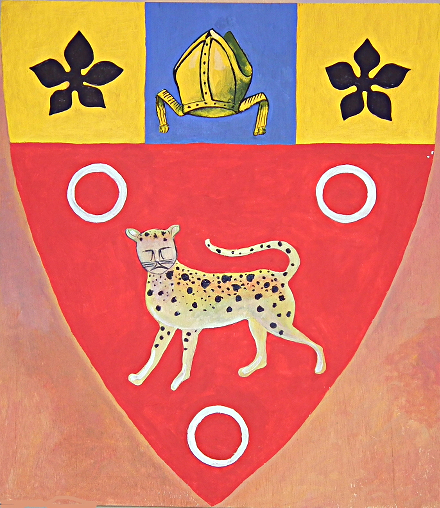 A further note refers to an inscription in the north aisle including the words 'Pray for the soule of John Brond and Agnes his wife, he died Janu. 26 1542'. [John and Agnes were the parents of Prior Robert] Sadly it appears that the armorial glass did not survive beyond the 19th century for the Norfolk historian, Bryant refers to:-
A further note refers to an inscription in the north aisle including the words 'Pray for the soule of John Brond and Agnes his wife, he died Janu. 26 1542'. [John and Agnes were the parents of Prior Robert] Sadly it appears that the armorial glass did not survive beyond the 19th century for the Norfolk historian, Bryant refers to:-
“...a canopied niche above the E window of the chancel... and facing in the E window were the effigies and arms of Prior Robert Bronde, alias Catton with his arms, and that this was on a clerestory window in 1723, Where is it now? And where are the other windows with the (?) arms”.
A historical note by Edmund Farrer (The Church Heraldry of Norfolk, 1887-1893) states that the armorial panel was “recently in a church window at Catton”. This also suggests that it had disappeared although not when.
Local historian Walter Rye* in 1919 states that bricks bearing a cat rebus once existed in the Manor House, but they can no longer be found. [In an interesting recent development the current resident of the Manor House, Mr Robert Radford, has interpreted the historic descriptions to make a shield with the coat of arms as it may have been - see illustration].
The four medieval panels are clearly of the same age. In 1519 Bronde had obtained obtained a papal bull and a licence from his bishop to assume the mitre, pastoral staff and other pontificals, an unusual privilege and one not known to have been granted to any other prior of Norwich. This adds weight to Bronde portraying himself in the glass as a Benedictine monk with the crozier. The female figure holding a lamb and a having a knife in her chest is clearly St Agnes, and it is suggested that this is a coded reference to Bronde's mother, Agnes. She and her husband John are taken to be portrayed as the “heads of donors” (in the Plumstead photograph). If the male head beneath the figure of Agnes is John it would seem to follow that the figure above the female head is St John the Evangelist. The fourth figure of what appears to be another Benedictine monk has been identified as St Bartholomew from the flaying knife he is carrying, although Bartholomew was not of the Benedictine order. However, the Parkin article (above) refers to 'effigies'; it therefore seems possible that this figure, so similar to Bronde with the crozier, is also Bronde. These are the earliest known images of Catton residents.
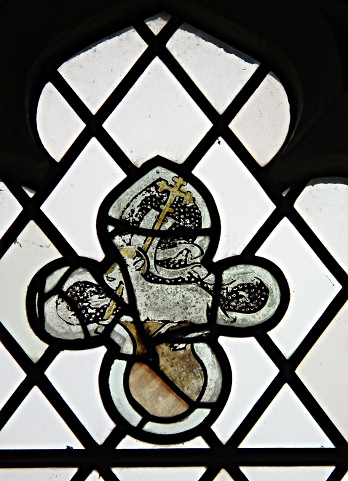 The quatrefoils are most intriguing. In he topmost at Plumstead (Agnus Dei - see above) the lamb holds a crozier in its front legs contains set against a mitre, all symbols of the high raking position of Prior Bronde in the church. Is this also another coded reference to Agnes? The heads of a male and a female portrayed in another quatrefoil are not unlike the two heads featured at the bottom of the full length images could they also be of Robert's parents?
The quatrefoils are most intriguing. In he topmost at Plumstead (Agnus Dei - see above) the lamb holds a crozier in its front legs contains set against a mitre, all symbols of the high raking position of Prior Bronde in the church. Is this also another coded reference to Agnes? The heads of a male and a female portrayed in another quatrefoil are not unlike the two heads featured at the bottom of the full length images could they also be of Robert's parents?
In 1850 and 1867 the incumbent, the Revd. Hart carried out major alterations to St Margaret's, including extensions to the chancel and the south aisle. It seems that the original glass in these windows was replaced with new glass at this time. Rye in 1919 made a derogatory reference to the church having been 'bedevilled by [the Revd.] Hart'.
Canon Noel Boston (Vicar of St Margaret's, 1939-1945) wrote a short 'History of Catton Church'. A framed copy stands on a windowsill in St Margaret's with the following information:-
“….....The other thing Hart did, however, is different: he filled the church with very poor glass indeed – the East window is his own work, work soon to be remedied. This East window was filled with glass about 1517 and also contained the likeness of Robert of Catton, Prior of Norwich and last Abbot of St Alban's. It contained the inscription: “Reverendus in Christo Pater Robertus Bronde, Prior Norwiciensis, ecclesie me vitriari fecit Ao Christi 1528”, “The Reverend Father in Christ Robert Bronde, Prior of Norwich in this church, caused me to be filled with glass”. There is some interesting medieval glass, mixed with later work, in the windows of the Dairy of the Hall. The parents of Robert Bronde lie buried in the Lady Chapel and a small brass commemorates them thus : Pray for the Soul of John Brond and Anne** his wife, the wiche John departed the xxvi daye of January, Anno Domini MVCXLII”. [1542]
It appears that the Bronde glass was removed from the east and possibly the south windows of St Margaret's by Hart during the 1850 and 1867 alterations. The 1850 work was paid for by the Morse family of Catton Hall, and the latter work by John Henry Gurney who bought the Hall in 1854, and it is surmised that it was he who took possession of the old glass. Little more is known of the windows, other than the remark by Canon Noel Boston concerning the dairy of Catton Hall, until it is found in Catton by Mrs Ketton-Cremer.
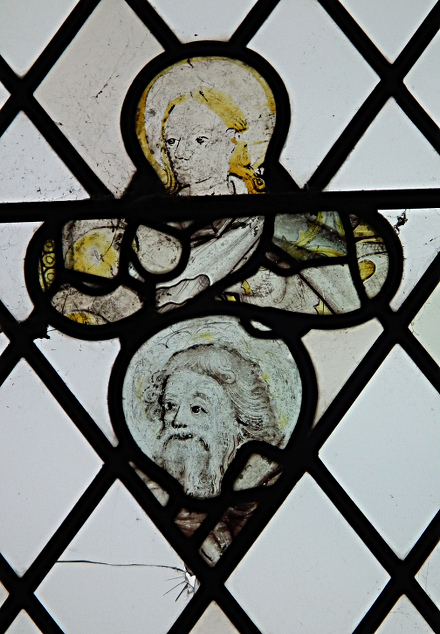 This raises some further questions. Daphne Harmer (nėe Buxton 1905) has an early recollection of the dairy as part of a complex of buildings separate group of building fronting Church Street including the main farm house and stables. We have on record an extract from her memoirs which includes detailed room by room descriptions of rooms in the Hall proper. There is no mention of any stained glass, although this is not definitive proof of it absence. Catton Hall was acquired by the County Council in 1948 and converted in to an old peoples' home. The County Council architect for the conversion has no recollection of any glass, nor does Andrew Buxton, then a young boy living in the Hall before it was sold. There is some doubt, therefore, that the glass was in Catton Hall proper in 1948 (loose or as a window) having so lately been seen by Canon Boston in the dairy.
This raises some further questions. Daphne Harmer (nėe Buxton 1905) has an early recollection of the dairy as part of a complex of buildings separate group of building fronting Church Street including the main farm house and stables. We have on record an extract from her memoirs which includes detailed room by room descriptions of rooms in the Hall proper. There is no mention of any stained glass, although this is not definitive proof of it absence. Catton Hall was acquired by the County Council in 1948 and converted in to an old peoples' home. The County Council architect for the conversion has no recollection of any glass, nor does Andrew Buxton, then a young boy living in the Hall before it was sold. There is some doubt, therefore, that the glass was in Catton Hall proper in 1948 (loose or as a window) having so lately been seen by Canon Boston in the dairy.
Had it therefore remained in the Dairy through to 1950 as part of the farm complex which remained in the ownership of the Buxton family for several more years? Ultimately the farm buildings were sold off and converted to a residential complex in the 1970s.
Having lain out of the public eye for almost a century it is something of a miracle that the glass survived in such good condition. Clearly there was no recognition in 1950 of the historical significance of the glass for Old Catton, but their discovery by Mrs Ketton-Kremer and the subsequent events ensured that the panels were preserved and returned to public to view for posterity.
Ray Jones, Old Catton Society, April 2013
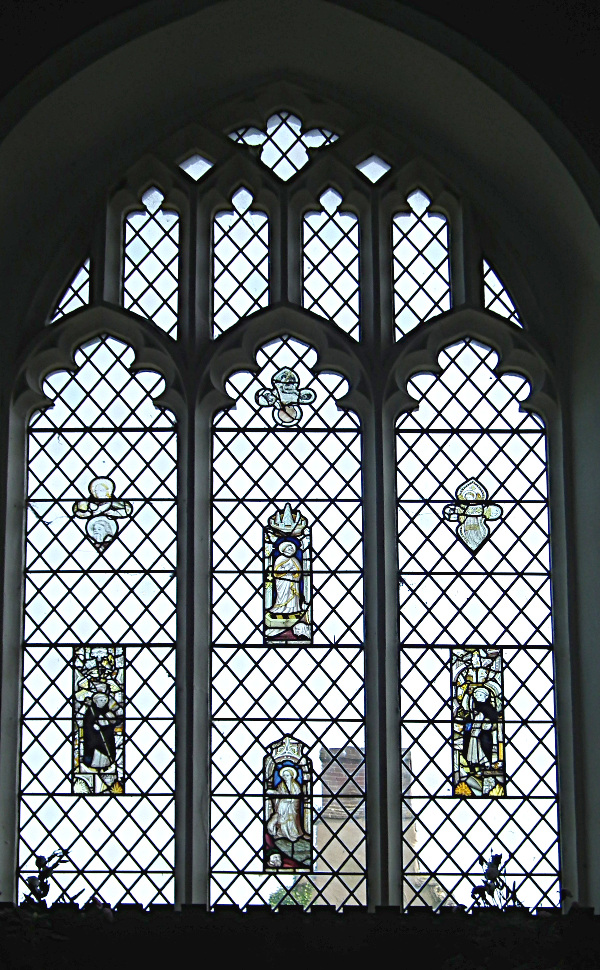
1 Coltart was an authority on Scottish church architecture and, in 1952, an elected member of Norfolk County Council. He died at Plumstead in 1964.
2 The company is no longer in business but all its records, including monochrome photographs of the windows as worked by them, are on deposit in the Norfolk County Record Office.
3 Almost certainly Christopher Woodforde, author of “The Norwich School of Glass-Painting in the Fifteenth Century”, published in 1950.
* Walter Rye - “History of the Parish of Catton”, 1919.
** Boston is clearly in error here.
Acknowledgements
The most recent leaflet in Plumstead was written by the Secretary of the Norfolk Round Churches Society, Lyn Stilgoe, who has given further help with this text. By an intriguing coincidence, she is the great-great-granddaughter of John Henry Gurney of Catton Hall.
Marian Prowse, and her brother Geoff Cook, descendants of Richard Bronde the brother of Robert, for prompted and assisted this research into a overlooked aspect of Old Catton history.
John Durdin, current churchwarden at Plumstead.
Robert Radford, Catton Manor House
Additional note
For a very detailed account of the career and extended family of Robert Bronde see the article by Mary and Terry Miller in “The Annual”, the Bulletin of the Norfolk Archaeological and Historical Research Group, No 15, 2006.
